On Santa Cruz, California’s largest island, foxes play and a traffic jam is 6 kayaks

California’s largest island, Santa Cruz, is part of Channel Islands National Park. And no, it’s not Catalina. It’s a territory of bold foxes, bald eagles, explorable sea cliffs and clifftop trails.
- Share via
Reporting from Santa Cruz Island, Calif. — Before I tell you about my glorious solitude on Santa Cruz Island, let’s be clear that there is some congestion among the coastal cliffs and grassy hills.
For instance, if there’s a sea caves tour, you might see half a dozen folks dragging yellow plastic vessels into the shallows, all at once. Kayak traffic.
For the record:
12:00 a.m. June 14, 2019Santa Cruz Island kayaks: In the June 9 Travel section, an articleabout Santa Cruz Island said that Channel Island Adventure Co. rentskayaks. The company leads kayak tours and rents snorkel gear, butdoes not rent kayaks.
If several couples decide to hike the Potato Harbor Overlook, you might meet them all on the clifftop at lunchtime, surveying the swells below. Foot traffic.
And on weekends, when boats from Ventura arrive, you will see scores of passengers come ashore at Scorpion Anchorage as a National Park Service ranger tells them what to expect here on California’s largest island. Tourist traffic, in its mildest form.
What you won’t find is cars, which is why I showed up in late spring for 48 hours of hiking, kayaking and camping.
The car-free life, after all, is a slow, quiet echo of how we once lived, a daydream an Angeleno may harbor. Depending on how technology evolves, we may have more car-free days ahead of us.
But I’m not waiting. In the months ahead, I’m hoping to visit several car-free destinations, beginning with this trip.
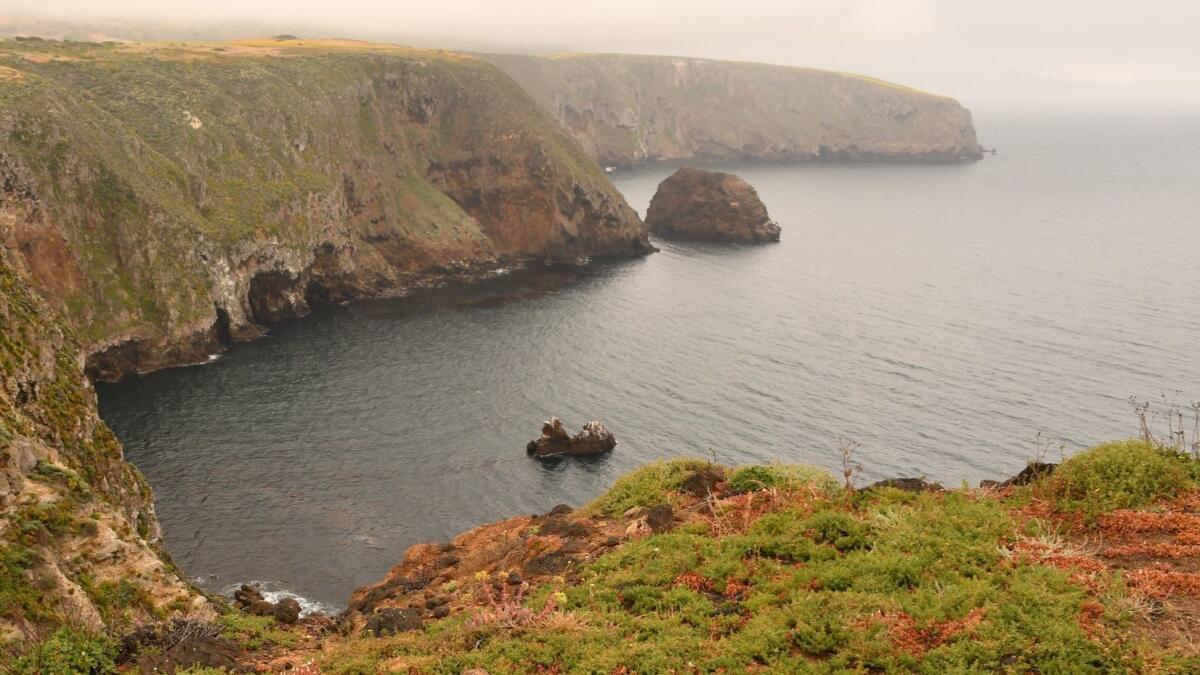
Santa Cruz, four times the size of Manhattan and not one-millionth as busy, is one of five islands that make up Channel Islands National Park. Visitors often describe it as a vision of what California must have looked like 300 years ago.
That’s not quite correct, because the island’s mix of plants and animals is the result of generations of human importation, extermination and experimentation. But it is a different Southern California from the one at the other end of the boat ride.
Quiet and carless
More than 10 million Californians live within 75 miles of this island. Many of them pay regular visits to Santa Catalina Island, car-free but busy, about 90 miles southeast. Yet on a weekend night, it’s rare to find 100 people on Santa Cruz Island.
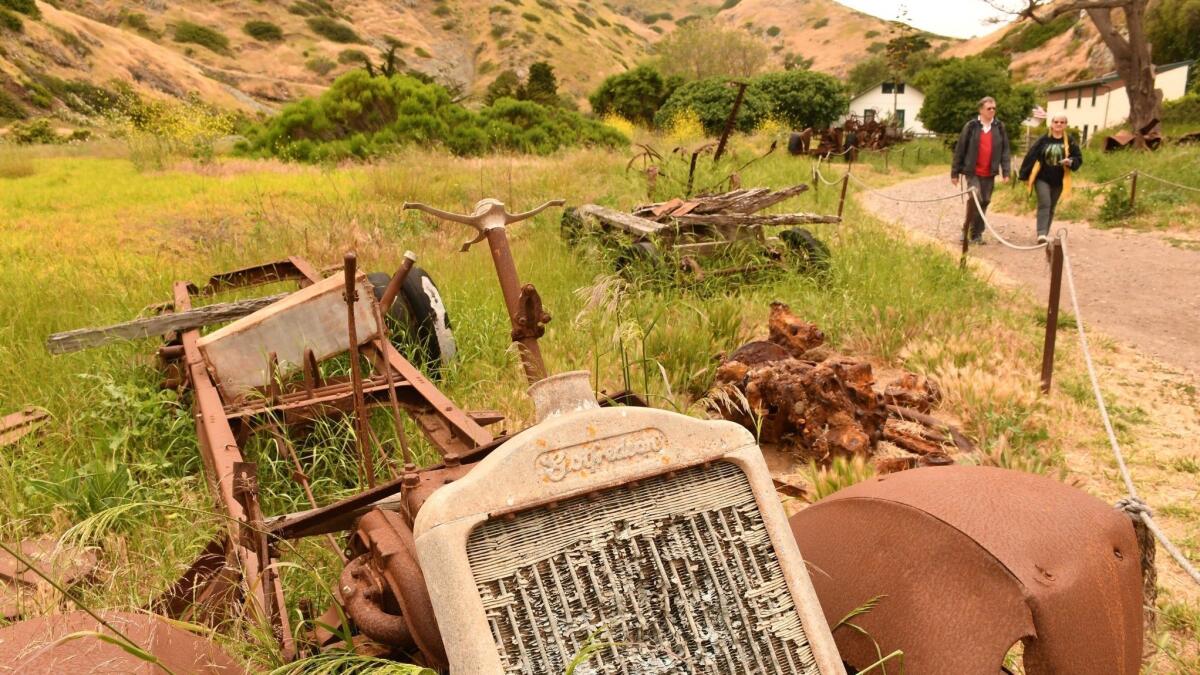
And there’s an incentive to visit soon. Beginning Nov. 1, rangers will close the Scorpion Anchorage pier and campground to install a new pier, which is expected to take six months or more. Rangers say Scorpion will reopen Dec. 21 through Jan. 5 for holiday season visitors, but the pier and campground will close again until the project is complete, perhaps by mid-2020.
No matter when you visit, chances are it will be by a boat ride from Ventura, typically about 75 minutes.
On the way, you may spot one or two dolphins, or perhaps, as I did, 200 leaping, squeaking, splashing dolphins and two or three kinds of seabirds. For a transcendent minute or two, the cold ocean seemed to be boiling with sea creatures, the dolphins eager to sidle as close to the boat as they could get. Not bad for $59 round trip (or $79 if you’re camping).
When the boat draws up to the short metal pier at Scorpion Anchorage, you see rugged cliffs and waves smashing into sea caves; wind ripples across hills covered with native and non-native grasses.
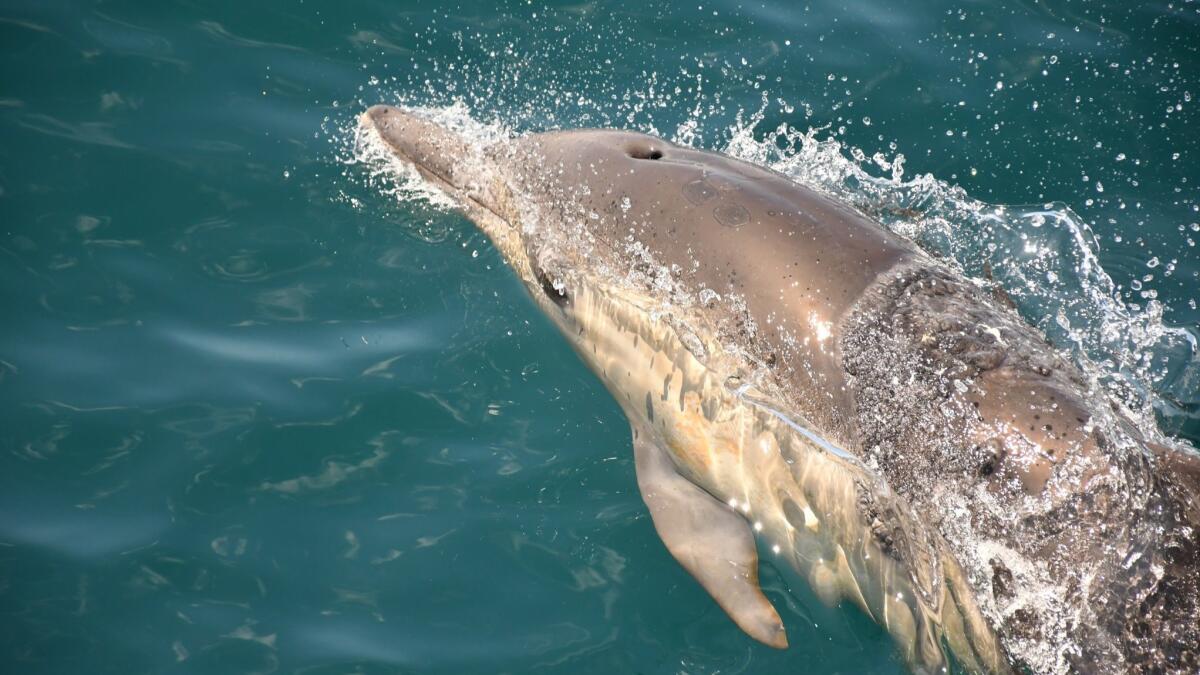
The island visitor center, which the National Park Service opened in 2009, is housed in an 1883 ranch building between the Scorpion beach and campground. The only cellphone reception is on the pier, and that is iffy, depending upon your carrier.
More visitors come just for the day, but there are 31 individual and group campsites, all overseen by the NPS, which owns the eastern quarter of Santa Cruz. The campground has picnic tables, potable water and pit toilets, but you’ll haul your trash home.
Three-quarters of the island, owned and run by the Nature Conservancy, is generally closed to the public. (But thanks to two webcams, you can spy on its growing bald eagle population.)
Before I carted my gear to the Scorpion Canyon Campground, a flat journey of about three-quarters of a mile, I stopped to listen for a minute. Birdsong. The rustle of wind rushing through the eucalyptus trees, a non-native grove that shades the campground. The rumble of a kayak being dragged across the pebbled beach.
Of sheep, pigs and foxes
You may have heard it said that you can never step twice into the same river. I now realize this is true of islands, too.
When I first camped on Santa Cruz in 1997, the park service had just finished acquiring the last of the land from the Gherini family, which had operated ranches for decades.
Feral sheep and pigs roamed the territory, nibbling at meager patches of grass. One evening as we sat around the campfire (now forbidden), half a dozen wild horses came barreling through the campground.
The second time I camped on the island, in 2004, Santa Cruz was greener. A drought had eased, and the sheep and horses were gone as were most of the pigs. (To finish that job, the park service had hired a team of hunters, whose tactics included sharpshooters in helicopters.)
On both visits, just about every ranger and visitor I met was worried about the little island fox. Unique to these islands, the species had been classified as endangered after an NPS estimate in 2000 that fewer than 80 of the animals remained on Santa Cruz.
I had never seen one in the wild. But this time, as I dragged my gear to the campsite, I looked up.
A fox stood alongside the path, appraising me like a pickpocket choosing its victims.
Its coat was rust and gray. It was about the size of my cats, but slimmer (4 to 5 pounds) and, to quote Casey Schreiner of Modern Hiker, “ridiculously adorable.”
Was this sighting incredible luck? No. A moment later another fox meandered across the path. Then another. There are now thousands on the island, so many that their endangered status was revoked three years ago.
As I set up camp, one of them jumped onto my gear, the better to sniff for food. I had to chase it around the picnic table three times before it would leave.
It took extreme vigilance to keep the critters from getting my food. (The metal food lockers next to the picnic tables, known as bear boxes in Yosemite, are called fox boxes here.)
By 9 p.m., I was in my sleeping bag. Then around midnight, the sound of a scuffle interrupted my dreams.
It was one fox chasing another across the mostly empty campground — an echo of those wild horses 22 years earlier, but lower to the ground, with paws instead of hooves. As they raced, one of the foxes let out a kind of banshee growl — louder and lower-pitched than I expected from an animal so small.
In the morning, fox poop was waiting in the middle of my picnic table.
Congratulations, island fox. In 22 years, you have made the journey from charity case to hardened criminal.
Swells and sea caves
For many visitors, the island’s north coast is the big draw with one of this continent’s greatest collections of sea caves.
For a sampling, I signed on for a three-hour kayak tour, pulled on a helmet and wet suit — quite welcome, given the cool water and wind — and started paddling.
There were about 10 of us, mostly novices, led by guides from Channel Island Adventure Co. (a subset of Santa Barbara Adventure Co.), which also rents snorkeling equipment at the old Scorpion Ranch corral.
For hardcore kayakers, the great temptation is Painted Cave, a quarter-mile long and up to 160 feet high, on the west end of the island. For me and my fellow paddlers, the many caves northwest and southeast of Scorpion Anchorage offered plenty of excitement.
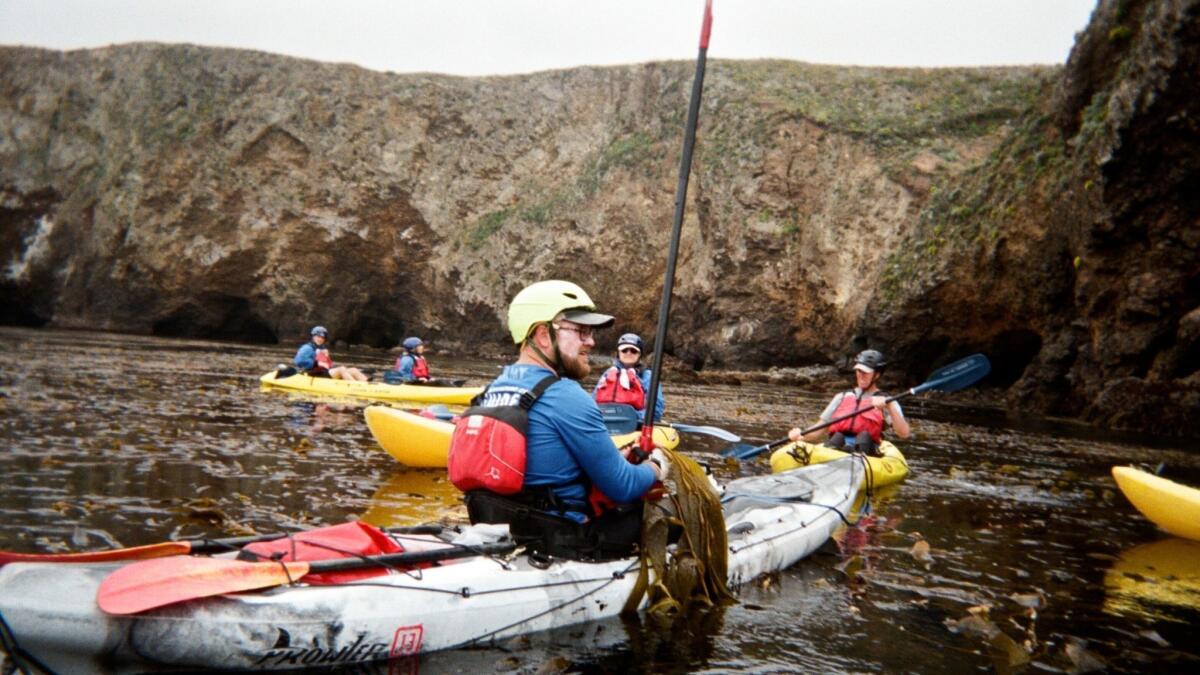
Guides Jeremy Carberry and Kyle Fischler looked after us, pointing out sea urchins and keyhole limpets and invoking the days when pygmy mammoths roamed the island (yes, really).
Some caves, such as Neptune’s Trident, were large enough for several of us to enter together. Shark’s Tooth was so snug and demanding that we paddled into the darkness one at a time, made a right turn, then followed another passage to daylight, leaning back to dodge the low ceiling.
This is a great thrill as long as you don’t have claustrophobia. A few paddlers did skip our last cave, a challenging formation named Marge because its opening matches the profile of Marge Simpson, tall hair and all. The passage was narrow, the water shallow and fast, but everyone who tried made it through.
The three-hour kayak tour isn’t cheap at $149 a head, but after 20 minutes, I knew I had invested well.
Across the hills and atop the cliffs
Hiking, on the other hand, is free. And that’s how I spent my second day on the island.
I could have walked to Smugglers Cove to the east (a 7½-mile out-and-back trip) or Montañon Ridge to the south (a challenging eight-mile loop with about 2,200 feet of elevation gain). But I’m a sucker for coastal clifftops.
So I set off on the Cavern Point Loop, then veered off that route to join the North Bluff Trail to the Potato Harbor Overlook. It was five miles round trip (about 300 feet of elevation gain), mostly hugging the clifftops on a wide trail lined with native and non-native vegetation.
“I’ve got to come up here and draw this tomorrow!” I overheard one artist-hiker tell her companion.
Most of the time, I had the trail to myself unless you count the bees, butterflies and the raven I saw carrying off somebody’s bagel.
Human habitation has a long history here. Before the Europeans showed up in the 17th century, the island was home to Chumash people and their predecessors for perhaps 10,000 years. They called the island Limuw and built as many as 10 villages, housing as many as 1,200 people.
By the early 19th century, the Spanish had been colonizing California for decades, and the last Chumash residents were leaving the island. By the 1860s, a sheep-ranching operation had taken over. In the 1930s, a new owner turned most of the island into a beef operation. The Scorpion area remained a working sheep ranch until 1984.
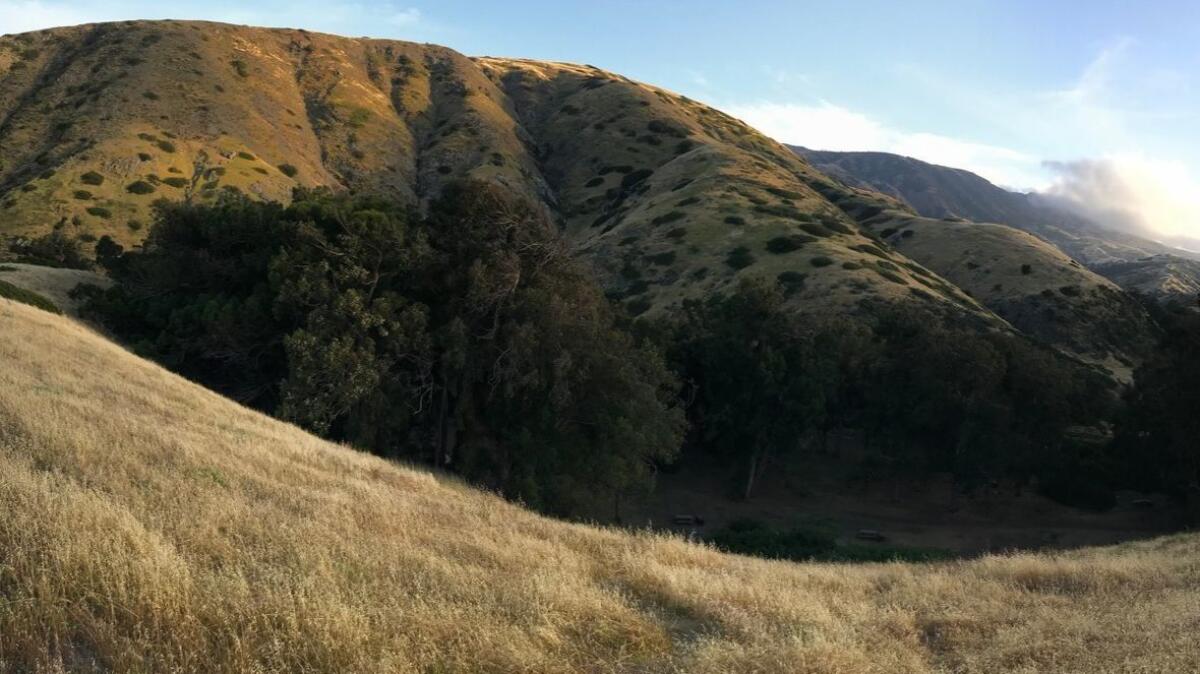
But on the trail, it’s easy to forget about people. Cavern Point was so rugged and gorgeous that I was reluctant to leave — all that purple, yellow and green vegetation, the pitted black volcanic rocks, the brown pelicans gliding on updrafts (another species recovery story), the 300-foot drop to the sea.
But eventually I did move on, and the Potato Harbor Overlook was nearly as wonderful — an excellent picnic spot with great views and plenty of privacy even with a dozen other hikers having their snacks.
“It’s my favorite place on Earth,” said Kendall Nash, a third-time visitor who lives in Cincinnati. She and friend Catie Bretz had slipped away from their husbands and children to spend several days in two California parks: Yosemite and the Channel Islands.
“When I meet people from L.A.,” Nash told me, “a lot of them have never been here, so I get to tell them all about their secret spot.”
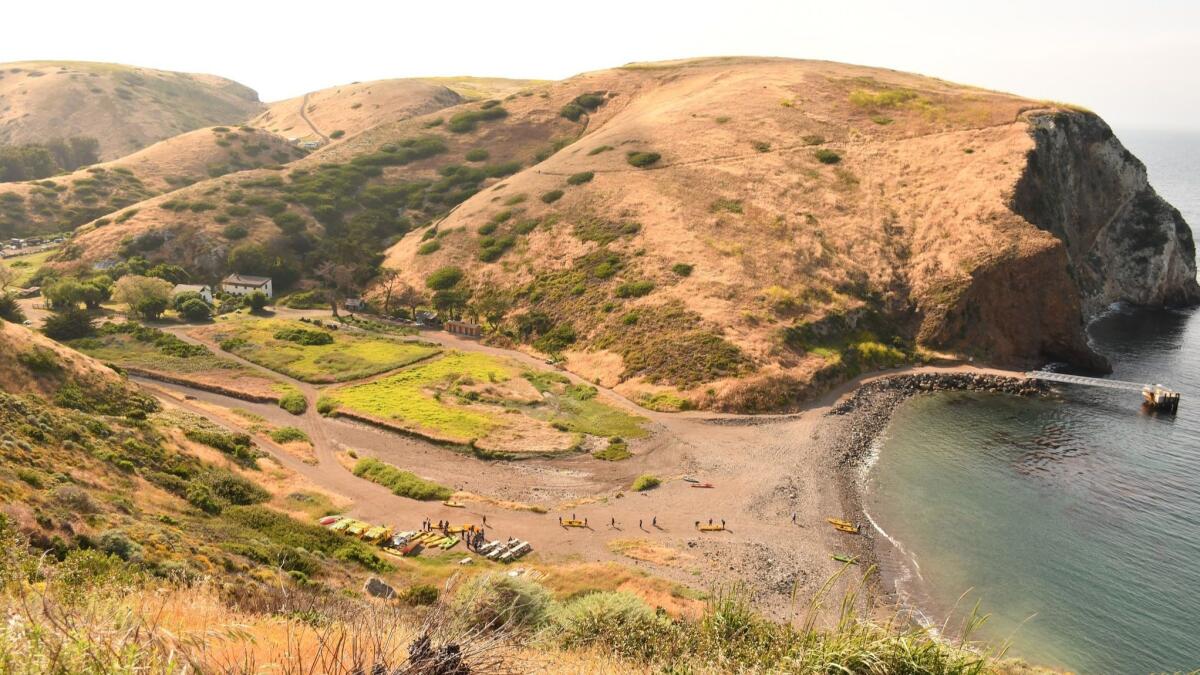
If you go
Island Packers, 1691 Spinnaker Drive, Suite 105B, Ventura; (805) 642-1393. Daily trips from Ventura Harbor to Santa Cruz Island. Round-trip adult fares from Ventura Harbor to Scorpion Anchorage on Santa Cruz are $59, or $79 for those camping.
Channel Islands National Park, (805) 658-5730, which includes Santa Cruz and four other islands, has its principal mainland visitor center at 1901 Spinnaker Drive in Ventura. The park also has an Outdoors Santa Barbara Visitor Center on that city’s waterfront at 113 Harbor Way, 4th Floor, Santa Barbara; (805) 456-8752. There’s no entrance fee for the park.
For camping reservations ($15 per individual site, up to six people), go to Recreation.gov or call (877) 444-6777. Summer weekends are often booked months ahead.
Santa Barbara Adventure Co., (805) 884-9283, and its subsidiary Channel Islands Adventure Co. offer kayak tours (ages 5 and older) and rent snorkeling gear. Most island kayaking tours cost $109 to $179 per adult.

L.A. Times Today airs Monday through Friday at 7 p.m. and 10 p.m. on Spectrum News 1.
Follow Reynolds on Twitter: @MrCSReynolds
More to Read
Sign up for The Wild
We’ll help you find the best places to hike, bike and run, as well as the perfect silent spots for meditation and yoga.
You may occasionally receive promotional content from the Los Angeles Times.







